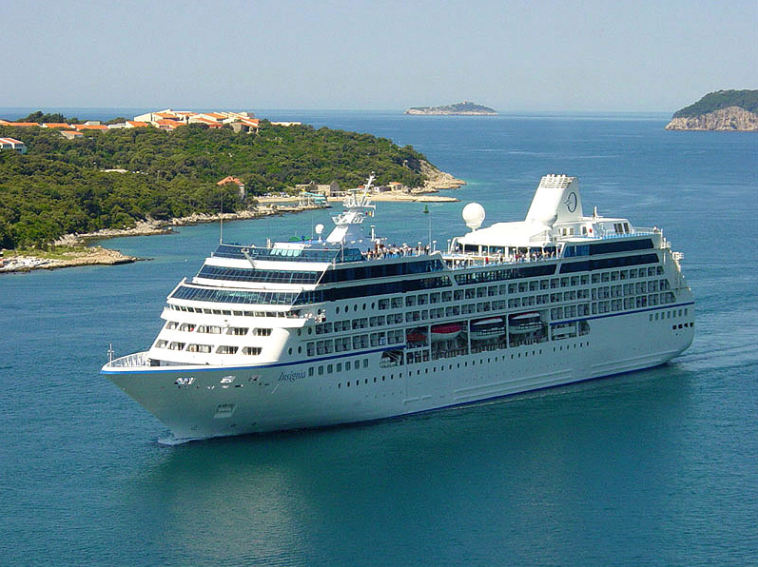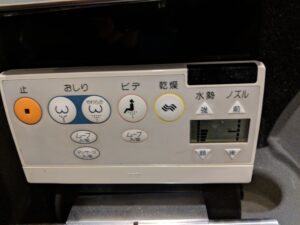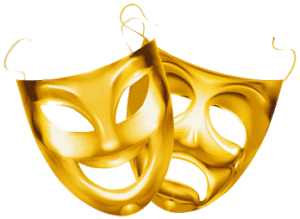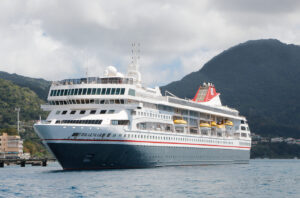
Cruising on the Oceania ship ‘Insignia’
We arrived in Tokyo on Saturday 30th March, after a long (a tad under 12 hours) but uneventful flight. I got talking to the chap sat next to me on the flight. I had wondered why he was receiving extra-special attention from the stewards and found out he’d been bumped from 1st Class to slum it with us economy erks in the rear stalls. I’m sure he was well compensated, but a pleasant chap all the same. He was an ex-Diplomatic Core Protection Officer, now working for Sky News. He didn’t say much about his current role, except it was something to do with anti-terrorism (methinks – “…wonder why he is on this flight…!!!”. Anyway, he was was happy to share the port and cheese with me and Lynda that one of the stewards delivered from 1st class. Nice chap.
We didn’t have much time to explore Tokyo, other than a walk from our hotel – the ANA Intercontinental – to the shopping district at Ginza. It was a good 40-minute walk, but helped us get over the jet-lag.
So, not much time really to go over my old Tokyo haunts in Roppongi (I was here 22 years ago when working for Reuters), but one thing that has changed since my last visit was – the toilets. It took me a while to get used to the various “bottom cleaning” options available. Only the inscrutable Japanese could come up with this invention. I wonder if it will catch on?!
| Mar 31 Sun | Tokyo, Japan |
| Apr 1 Mon | Cruising the Seto Inland Sea |
| Apr 2 Tue | Hiroshima, Japan |
| Apr 3 Wed | Kagoshima, Japan |
| Apr 4 Thu | Sasebo, Japan |
| Apr 5 Fri | Cruising the East China Sea |
| Apr 6 Sat | Cruising the Yellow Sea |
| Apr 7 Sun | Beijing (Tianjin), China |
| Apr 8 Mon | Cruising the East China Sea |
| Apr 9 Tue | Shanghai, China |
| Apr 10 Wed | Shanghai, China |
| Apr 11 Thu | Shanghai, China |
| Apr 12 Fri | Cruising the East China Sea |
| Apr 13 Sat | Hong Kong, China |
| Apr 14 Sun | Hong Kong, China |
| Apr 15 Mon | Cruising the South China Sea |
| Apr 16 Tue | Hue (Da Nang), Vietnam |
| Apr 17 Wed | Cruising the South China Sea |
| Apr 18 Thu | Saigon (Ho Chi Minh City), Vietnam |
| Apr 19 Fri | Saigon (Ho Chi Minh City), Vietnam |
| Apr 20 Sat | Cruising the Gulf of Thailand |
| Apr 21 Sun | Bangkok, Thailand |
| Apr 22 Mon | Bangkok, Thailand |
| Apr 23 Tue | Ko Samui, Thailand |
| Apr 24 Wed | Cruising the Gulf of Thailand |
| Apr 25 Thu | Singapore, Singapore |
Here’s the map:
Our first cruise on the Insignia, but it’s very much the same as the Sirena and Nautica, which we’ve previously cruised on, so we quickly found our bearings once we had boarded. We prefer the small cruise ships. The Insignia has capacity for 684 guests and 400 crew, and has only recently had a full refurbishment (2018)

1st April, at sea, on our way to Hiroshima.
2nd April, Hiroshima. Visited the Hiroshima Peace Memorial Park today, the site of where the first nuclear bomb was detonated. On August 6th, 1945, the B-29 Superfortress Enola Gay dropped the bomb and what is today this park was then Ground Zero. The explosion destroyed most of the city and left only a few concrete and steel structures still standing. The most prominent was once the Hiroshima Prefecture Industrial Promotion Hall, the ruins of which are now a UNESCO World Heritage Site referred to as the Atomic Bomb Dome. The Children’s Peace Monument, often called the Statue of the A-Bomb Children, honours the thousands of children that we’re killed. built after the war as a memorial to the people who died in the Atomic Bomb attack (6th August 1945). The Atomic Bomb Dome was the only structure left standing. The Children’s Peace Monument honours the thousands of children who died. In all, there were 140,000 people who died, representing a third of the population.
Hondori street for shopping.
Miyajima Island for Itsukushima shrine and famous Red Torri gate. The shrine was established in 593, the first year of the reign of Empress Suiko, and today is a UNESCO World Heritage Site.
On a more upbeat note, we also visited the beautiful Miyajima Island, where we saw the Itsukushima Shrine and the famous torii gate that rises up out of the ocean.
The spring blossom is everywhere, life is precious.
Total cost if our self-organised excursion, including the Memorial Park, the Memorial Museum, public transport to the Ferry Terminal, return ferry fare to Myajima Island and taxi back to the ship was 7,900 Yen, or £54 ($67), i.e. for two people. This compares to the Oceania organised tour price of $339 PER PERSON!
3rd April, arrived Kagoshima, dominated by the majestic and active volcano, My Sakurajima, towering over 3,500 feet above the city and bay. In the mid 1800s, the English Royal Navy bombarded the city in their efforts to collect on a perceived debt.
Walked to the Shiroyama Observatory, beautiful panoramic view over the city.
4th April, Sasebo. Longest shopping street in Japan.
5th April, cruising the Yellow Sea en route to Beijing.
6th April, cruising the Yellow Sea en route to Beijing.
7th April, Tianjin, for the Great Wall of China.
The Great Wall of China actually consists of numerous walls and fortifications. Many running parallel to each other. Original conceived by Emperor Qin Huang (c. 259-210 B.C.) in the third century B.C as a means of preventing incursions from barbarian nomads into the Chinese Empire, the wall is one of the most extensive construction projects ever completed.
The best-known and best-preserved sections of the Great Wall was built in the 14th through 17th centuries A.D., during the Ming dynasty (1368 – 1644). Though the Great Wall never effectively prevented invaders from entering China, it came to function more as a psychological barrier between Chinese civilization and the world and remains a powerful symbol of the country’s enduring strength.
Construction of the “Wan Li Cheng”, or 10,000-Li-Long Wall, was one of the mots ambitious building projects ever undertaken by any civilisation. The famous general Meng Tian directed the project and was said to have used a massive army of soldiers, convicts and commoners as workers. Made mostly of earth and stone, the wall stretched from the China Sea port of Shanhaiguan over 3000 miles west into Gansu province. In some strategic areas, sections of the wall overlapped for maximum security. From a base of 15 to 50 feet, the Great Wall rose some 15-30 feet height and was topped by ramparts 12 feet or higher; guard towers were distributed at intervals along it.
Today, the Great Wall is generally recognised as one of the most impressive architectural feats in history. In 1987, UNESCO designated the Great Wall a World Heritage site. Over the years, roadways have been cut through the wall in various points, and many sections have deteriorated after centuries of neglect.
8th April, cruising the East China Sea, en route to Shanghai
9th April, Shanghai, China. Shanghai docks closed due to fog. We stayed at anchor in the East China Sea, 64 miles from Shanghai.
10th April, Shanghai, China. The fog lifted late afternoon of the 9th and we docked at 5.30am. Went on an organised tour visiting the ‘old’ and the ‘new’ Shanghai. This started with a scenic drive down the Bund and visit to the former French concession area. We then visited the People’s Square, traversed the tunnel under Huangpu River to the Pudong District arriving for photos of the iconic Oriental Pearl TV Tower. The tour finished with a drive to the Jin Mao Building and an express elevator ride to the Observation Lounge on the 88th floor. Amazing panoramic views of Shanghai.
In the afternoon we took a leisurely stroll to Yuyuan Garden and Fangbang Road, the centre for local Chinese goods, arts and crafts. On the walk back to the chip, we stopped off at the Peace Hotel in what was once the British Concession Area and found the famous “Old Jazz Band”. Old being the operative word; they were ancient, and the ‘jazz’ music was more fitting for a funeral wake. The bass player played the same two notes for every tune they played, and the drummer often disappeared into his own world!
We finished the day at a Japanese restaurant quite close to where our ship was docked. We only had enough local currency left to buy a couple of beers and some bar snacks, but we had some very good live music performed by a young guy with a guitar. We also witnessed a very public proposal from a young Japanese lad to his girlfriend, digitally recorded and no doubt posted to social media by all of her friends. We congratulated the young couple as we left to go back to our ship.
11th April, cruising the East China Sea en route to Hong Kong. Hoping the weather will soon get warmer, we’ve had a chill wind for the past three or four days.
12th April, cruising the East China Sea en route to Hong Kong
13th April, Hong Kong. Docked at Ocean Terminal South, right outside the massive Harbour City shopping mall. Designer outlets on three floors. Ventured out in Kowloon, walking up Nathan Road to the Temple Street Night Market. In the evening we ate local Cantonese cuisine in one of the Harbour City restaurants.
14th April, Hong Kong. Did the ‘Big Bus’ hop on-off bus tour. Quite costly at 900 HKD for the both of us, but it did include the vernacular tram ride to Victoria Peak, and (useful tip) fast-tracked us past the huge queues for the Peak. Also visited Ocean Pass, Repulse Bay and Stanley. Weather not so good, so most of the latter part of the day spent under plastic macs.
15th April, Cruising the South China Sea, en route to Da Nang, Vietnam.
16th April, docked at Da Nang, Vietnam. Navigated our way to the XQ Da Nang Silk Hand Embroidery shop on Tran Phu street. Amazing artistry and skill of the women working with fine needlepoint to create lifelike silk tapestries depicting local scenes, flowers and portraits. Bought two silk pictures for $250 – a bargain when you consider these would cost four times that much in the UK. Then onto the Han Market to pick up local bargains. Lynda came away with a beautiful silk Ao Dai (the traditional Vietnamese dress) made to measure in 1 hour, and also an embroidered top. Wandered around the two floors of the market, never quite sure what all the goods and produce were that were laid out in symmetrical patterns. Have always admired the work ethic of the Vietnamese; everyone seems to be an entrepreneur. Love the place.
17th April, cruising the South China Sea en route to Ho Chi Minh City (Saigon).
18th April, Ho Chi Minh City (Saigon), Vietnam. On tour to Mekong River Delta. Drove to the delta port of My Tho. Visited the Vinh Trang Pagoda, then a short boat trip on the Mekong River to Unicorn island, where we visited a bee farm and tried the local honey and tea drink. Then visited a family-run coconut candy manufacturing enterprise. There was virtually no automation from start to end of the process, and every candy individually wrapped by hand. We then had a brief sampan ride, rowed furiously by a young lad at the bow and a slightly older man at the stern. The tour was rounded off by an excellent lunch, where we tried ‘elephant fish’, sticky rice, spring rolls and the local ‘Pho’ soup. All of it fresh and delicious.
19th April, Ho Chi Minh City (Saigon), Vietnam. Much of this was a reminiscence of my time here 10 years ago. So much has changed in that time, mainly the many tall buildings that have sprung up throughout the city. The traffic is still chaotic with many thousands of mopeds vying for space on the roads. Crossing the road requires a conviction that you will be spotted by the oncoming cacophony of mopeds, who will steer round you, like a fast-moving river. We visited the Reunification Palace, now knee deep with tourists – of which we were two! By comparison it was fairly quiet here 10 years ago when tourism was still in its infancy.
We also visited the Notre Dame cathedral, which was closed due to renovation (similar to its namesake in Paris, having recently heard on the news about the fire there). While in the vicinity, we visited the iconic Central Post Office, built between 1886 and 1991 and designed by the famous French architect Gustav Eiffel. Its interior has remained essentially untouched since its construction and is still in operation as a post office. Took a few pictures of the ex-CIA building, now framed by a new office block directly behind it. This was the scene of the final evacuation of US military personal and their families to the waiting helicopter on the roof as the North Vietnamese army and Vietcong entered the outskirts of the city on the 30th April 1975. A bit of trivia – the evacuation was triggered by the broadcast of the song “White Christmas” sung by Elvis Presley.
We then moved on to visit a lacquerware workshop where we witnessed the artistry and skills of the workers who create these pieces, using mother of pearl, duck shell and/or hand painting to create incredibly detailed pictures. Totally reliant on manual labour and time-consuming production processes. Our next stop was the Giac Lam Pagoda and then a very brief visit to the An Dong market in Cholon Town, where every variety of local produce could be bought, from cashew nuts to dried seahorse.
Our next stop was a local coffee shop, where we sampled (and bought) some ‘Weasel Coffee’. Though carnivores, this type of weasel only eats coffee beans during the harvesting season, which pass through it’s digestive system to end up as Weasel Coffee. It’s not as bad as it sounds, very mellow with a slight caramel taste.
Our final stop was the roof garden of the Rex Hotel, scene of lively nightlife prior to and during the Vietnam war, and haunt of many of the US military who were based there. One last observation – McDonalds and KFC were now in evidence in the city, their invasion succeeding where the US military failed. Such a pity when the Vietnamese food and culture is so much better than these US imports. I guess it had to happen!
20th April 2019, cruising the Gulf of Thailand en route to Bangkok
21st April 2019, Bangok. No real plan of what we were going to do today. The shuttle bus dropped us off at Central World Plaza – good for shopping if you’re not looking for bargains. Many western shops, but prices at least equivalent if not slightly more expensive than London. We then had the good fortune to be stopped in the street by a local man who could probably see were (a) tourists and (b) not too sure where we were headed. He suggested we visit the Chinese market at Yaowarat Road but told us it would not be open until 4.30pm. In the mean time we could do a river tour on a ‘long tail’, one of many boats that buzz around the Bangkok rivers and canals with huge engines and long propeller shafts. His colleague marked on our map where we could board one of these craft, the price we should pay (no more than 2,800 Baht for the two of us), and the price of a tuk-tuk to get us there – no more than 1000 Baht.
Having hailed a tuk-tuk for us, explaining to the driver where we were headed and negotiating the price for us, we thanked our newly made local friends and duly set off for a frantic drive across Bangkok, weaving in and out of lines of traffic and occasionally (but not always) observing traffic signals, we finally arrived at Pier 1 on the Chao Phraya River. The tuk-tuk driver insisted on scouring us right to the boat and pointed out the price written on our map (2,800 Baht) for the trip. Having settled on the sum, boarded the boat, we began our adventure into the rivers, canals and backwaters of Bangkok. The tour lasted a little over 1.5 hours, and Lynda and I both agreed it was the one of the best things we’ve ever experienced.
We saw the floating market, a fish farm, the Royal Palace, the Temple of the Emerald Buddha, and numerous other temples and markets, all from the comfort of our boat – and incidentally, we were the only passengers. At the end of our tour, the boat driver dropped us at Chinatown where we navigated ourselves to the market, and then onto the Sampeng Market in the Indian quarter. It was then a tuk-tuk ride back to Central World Plaza, with the idea of visiting the new Red Sky roof-top bar on the 55th floor of the Centara Grand. A mistake, since we did not comply with the dress code (no shorts allowed), so back to the tuk-tuk and another hair-raising journey across town to Patpong. My last visit there was in 1973/4 with the Royal Navy. It’s gone a bit up-market since then, but there’s still lots of rather seedy bars, and men selling a menu of girl activities that I won’t go into here. We satisfied ourselves with a few beers at one of the more reputable places (Shenanigans Irish Bar), before decamping to find a restaurant serving good quality Thai food. We had an excellent meal and then found taxi to take us back to the ship. Back on board for 10.30pm, having left the ship at 1.15pm.
A full day and one to remember. We knew it was hot during the day, but we heard later that it was over 45C (113F). At least we benefited from a cool breeze on our river excursion – highly recommended for anyone visiting Bangkok.
22nd April, Bangkok – relaxing day on board, then sail for Ko Samui.
23rd April, Ko Samui, ThailandTender operation. Bought silk goods. Ate lunch. Back on board.
24th April, Crusing the Gulf of Thailand, en route to Singapore.
25th – 27th April, Singapore. So much has changed here, especially all the new building in the financial district and the landscaping of the Bay area. We visited the Bay Flower Gardens, overlooked by the iconic
In the evening we sampled our all-time favourite Singaporean food – chili crab, with our friends from the ship, Bill and Wray. With thanks to my ex-Reuters colleague, Pamela Tan for recommending the Palm Beach, overlooking The Bay. An excellent evening. We then walked across to the Ritz-Carlton for drinks with Pamela Tan and her father.
The following day it rained, so where better to seek shelter than the Long Bar at the Raffles Hotel. The hotel was closed for refurbishment, but the Long Bar was open. They probably can’t afford to close it when charging $38 for a Singapore Sling! We
limited ourselves to just the one each and then went on to the (slightly) cheaper wine.
In the evening we had a farewell dinner with Bill and Wray from the cruise ship. I hope we’ll keep in touch.
And so we come to the end of this epic journey. Probably one of the best holiday’s we’ve had, so many places we visited, and such a contract in cultures in each country we visited. Westerners tend to think of SE Asian’s as one homogenous people, but they have completely different traditions and cultures. I highly recommend visiting them!
More photos on Flickr












